As you step off the plane in Crete, that familiar scent of wild herbs carried on the warm breeze welcomes you back like an old friend. For those of us who have returned to Crete year after year, the island has become more than just a holiday destination – it’s a place that feels like a second home, a sanctuary we carry in our hearts. These aromatic treasures are more than just souvenirs – they’re a piece of the island’s soul that we can take with us, bridging the gap between visits to our beloved Cretan shores.

Cretan herbs are a testament to the island’s rich biodiversity and age-old traditions. Each one tells a story of sun-baked hillsides, ancient wisdom, and the hands of local foragers who have passed down their knowledge through generations. These aren’t just flavorings for your kitchen or remedies for your ailments; they’re a connection to the Cretan way of life that has captivated us for so long.
Let’s explore 12 must-have herbs that no Crete enthusiast should leave the island without.
1. Greek Oregano: The Heart of Cretan Cuisine
There’s oregano, and then there’s Greek oregano from Crete (Origanum vulgare hirtum). Known affectionately as “Cretan Gold,” this robust, flavorful powerhouse captures the very essence of the island’s sun-baked hillsides. Its name, derived from the Greek words “oros” (mountain) and “ganos” (joy), literally means “joy of the mountain” – a fitting description for this beloved herb.
In Greek mythology, oregano was a gift from Aphrodite, the goddess of love, who grew it in her garden on Mount Olympus as a symbol of happiness. This divine connection extends to mortal unions as well – in ancient Greece, newlyweds were crowned with oregano as a blessing for their marriage.

Open a bag of authentic Cretan oregano, and the intense aroma instantly transports you to those leisurely lunches in sun-drenched tavernas. It’s the scent of lamb slow-roasting over open fires and vibrant Greek salads glistening with local olive oil. This oregano is as fundamental to Cretan cuisine as the island’s famous olive oil itself, finding its way into almost every savory dish, from salads to meats to cheeses.
Oregano’s role extends beyond the kitchen. For centuries, Cretans have used oregano-infused olive oil to treat skin infections and wounds, leveraging its potent antimicrobial properties. This practice dates back to ancient times – Hippocrates, the father of medicine, prescribed oregano for various ailments in the 5th century BC. Ancient Greeks even believed oregano could ward off evil spirits, planting it around their homes for protection.
The wild oregano of Crete is particularly prized, so much so that it’s protected by European law to prevent extinction. This protection stems in part from the dangerous tradition of “erondades” (love seekers) who would risk their lives climbing steep mountain faces to collect wild oregano as a gesture of love.

Recent studies have shown that Greek oregano is rich in antioxidants, particularly carvacrol and thymol, which may help reduce inflammation in the body and support overall immune function.
When selecting your oregano, look for deep green leaves with a strong, pungent aroma. Quality Cretan oregano should be hand-picked and dried naturally. Use it liberally in your cooking, steep it for a comforting tea, or infuse it in olive oil for a traditional remedy. By choosing authentic Cretan oregano, you’re not just buying a herb – you’re embracing a tradition that spans millennia, valuing quality, sustainability, and connection to the land.
2. Dittany of Crete: The Mythical Healer
Dittany of Crete (Origanum dictamnus), a rare endemic plant, is more than just an herb—it’s a living legend. Its name, derived from “Δίκτη” (Dikte), a Cretan mountain range, and “θάμνος” (thamnos), meaning shrub, hints at its deep roots in the island’s culture.
Growing wild on steep mountainsides, dittany’s fuzzy leaves and delicate pink to purple flowers embody the resilience of Cretan flora. Cretans call it “erontas” (love), echoing the Greek myth where Aphrodite used it to heal Aeneas’ wounds.

This mythical association reflects dittany’s potent healing properties. Hippocrates prescribed it for digestive issues, tuberculosis, and to induce menstruation. Aristotle noted that wounded wild goats in Crete sought out dittany, believing it helped eject arrows from their bodies.
Cretan shepherds have long used dittany to treat wounds and fractures in their flocks, while its antiseptic and anti-inflammatory properties make it effective for respiratory issues and sore throats. In Cretan cuisine, it adds a unique flavor to vermouth and absinthe.
When purchasing, look for whole, dried leaves with a strong, oregano-like scent from reputable sources. Use it for aromatic teas or as a peppery addition to your cooking, knowing you’re partaking in a tradition as old as Cretan civilization itself.
3. Greek Sage: The Memory Keeper
Greek sage (Salvia fruticosa), with its velvety leaves and delicate purple flowers, has been a cornerstone of Cretan herbal tradition for millennia. Its genus name, “Salvia,” derives from the Latin “salvere” (to save or heal), hinting at its long-standing medicinal use.
Known to ancient Greeks as “elelisphacos,” sage was highly prized for its healing properties. Theophrastus, the father of botany, documented its virtues in the 4th century BCE. In Greek mythology, sage was linked to Zeus and immortality, believed to grant wisdom and even eternal life.
This reverence for sage continues in Cretan culture. Traditionally, dried sage bunches are hung in doorways or burned as incense to ward off evil spirits. In the kitchen, Greek sage lends its unique flavor to meat dishes, local cheeses, and traditional herbal tea blends.

Modern science supports the ancients’ belief in sage’s cognitive benefits. Recent studies suggest that Greek sage (Salvia fruticosa) may even outperform common sage (Salvia officinalis) in enhancing memory and attention across age groups. These findings echo the traditional use of sage tea in Cretan folk medicine as a remedy for digestive issues, fever, and as a general health tonic.
Cretans have long used sage to treat various ailments, leveraging its potent antimicrobial properties for sore throats and mouth infections. Women often turn to sage tea to alleviate menstrual discomfort and menopausal symptoms.
When selecting Greek sage, look for silvery-green leaves with a strong, earthy aroma. Whether used fresh or dried in cooking, or steeped as a soothing tea, Greek sage offers a taste of Cretan wisdom and a potential boost to your memory.
4. Cretan Thyme: Mountain Essence
Cretan thyme (Thymus capitatus), whose genus name derives from the Greek “thymos” meaning courage or strength, carpets the island’s mountainsides. Its tiny leaves and purple flowers fill the air with a pungent, earthy scent, a presence that dates back to the Minoan civilization.

Historically, thyme has been associated with bravery. Ancient Greeks burned it as incense in temples and used it in fragrant oils. Greek soldiers bathed in thyme-infused water before battle, believing it imparted courage. This tradition of use continued through the ages, with archaeological evidence suggesting its importance in Minoan rituals and daily life.
The high concentration of thymol in Cretan thyme makes it a powerful natural antiseptic. In Cretan folk medicine, thyme tea is used to treat respiratory issues, digestive problems, and boost the immune system. Recent studies suggest that thyme may have mood-enhancing properties and potent antimicrobial effects against foodborne pathogens.

In Cretan cuisine, thyme is indispensable. It flavors everything from grilled meats to cheese and is a key ingredient in “throumbi,” an herb mixture used to flavor olives. Moreover, Cretan thyme is crucial for producing some of the island’s finest honey, serving as an important nectar source for honeybees.
Cretan thyme’s ability to thrive in dry, rocky terrain makes it perfectly adapted to the island’s environment. It’s traditionally harvested during summer when in full bloom, ensuring the highest concentration of essential oils.
When purchasing, look for thyme with bright green leaves and a strong, spicy aroma. Whether used liberally in cooking or brewed into a fortifying tea, Cretan thyme offers a taste of the island’s rugged landscape and centuries of herbal wisdom.
5. Malotira: Shepherd’s Tea of the Mountains
Malotira, or Cretan Mountain Tea (Sideritis syriaca), is a powerhouse of health benefits wrapped in an unassuming package of fuzzy leaves and bright yellow flowers. This endemic Cretan herb has been the go-to remedy for locals since ancient times, even earning a mention in Dioscorides’ “De Materia Medica.”
Its name, derived from the Italian “male” (illness) and “tirare” (to pull), aptly describes its reputation for “pulling out illness.” In Greek mythology, it was believed that the gods drank Malotira tea to maintain their immortality. Today, it’s often cited as a contributor to the renowned longevity of Cretan people.
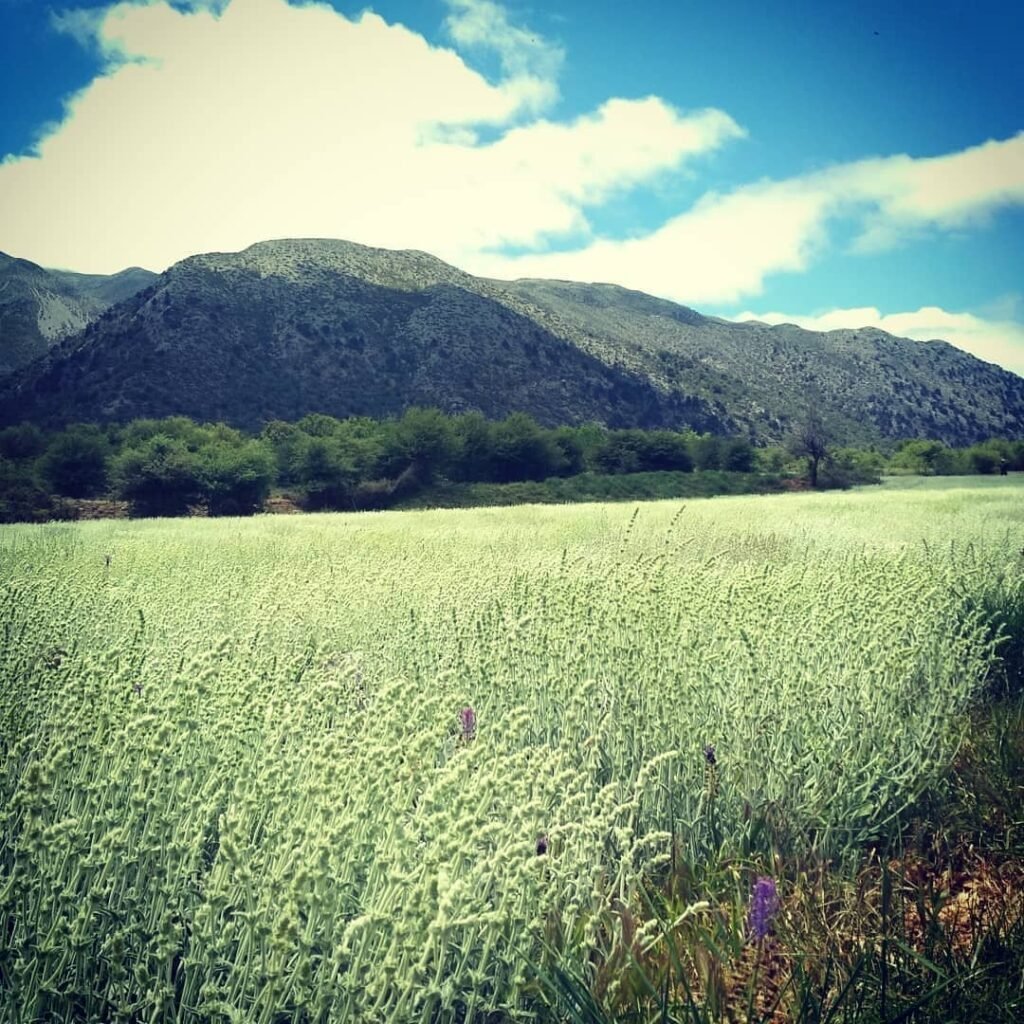
Traditionally, young men called “erondades” would brave dangerous mountain slopes to harvest Malotira, often as a display of courage to impress young women. Cretan shepherds have long brewed this tea to ward off cold and boost immunity during long days in the rugged mountains.
Modern science is validating these traditional uses. Studies suggest that Malotira is rich in antioxidants and has anti-inflammatory, antimicrobial, and potentially neuroprotective properties. It’s been linked to improving digestion, reducing anxiety, supporting respiratory health, and even potentially fighting certain types of cancer and Alzheimer’s disease.
In Cretan cuisine, Malotira extends beyond its medicinal uses, flavoring local cheeses and herbal liqueurs. Its ability to thrive in Crete’s harsh, rocky terrain mirrors the resilience of the Cretan people themselves.
When brewing Malotira, remember: a little goes a long way. Steep a small handful in hot water for about 10 minutes, perhaps with a dollop of Cretan honey. As you sip, let the warm, earthy notes transport you to the sun-drenched slopes of Crete. And here’s a local tip: in Crete, you’ll often find Malotira served as a refreshing iced tea during the hot summer months.
6. Cretan Marjoram: The Endangered Mountain Jewel
Hidden in the rugged landscape of Crete’s Dikti mountains, Cretan Marjoram (Origanum microphyllum), or micro-leaved oregano, is a true island endemic. This petite herb, with grey-green leaves barely reaching 4mm, packs a flavor that belies its size. In ancient Greece, oregano was known as the “joy of the mountains”, a name this diminutive variety certainly lives up to.

Legend has it that Aphrodite, the goddess of love, grew marjoram (Origanum majorana, a close relative) in her garden on Mount Olympus. This divine connection may explain why oregano species were often used in love potions and wedding crowns – a tradition some Greek brides still follow today. Origanum microphyllum carries on this romantic legacy in its native Crete.
Cretan locals have long prized this herb for both culinary and medicinal uses. Traditionally, it’s been used to soothe digestive issues, ease headaches, and calm anxiety. In the kitchen, its delicate yet distinct flavor enhances grilled meats, vegetable dishes, and even summer drinks.

Sadly, Origanum microphyllum is now critically endangered due to overharvesting. The good news? It adapts well to cultivation, offering a sustainable way to enjoy its benefits. When in Crete, look for sustainably sourced options to bring home a unique piece of the island’s herbal heritage while helping preserve this tiny treasure.
Pro tip: Add this herb towards the end of cooking to preserve its subtle nuances. Whether you’re drawn to its flavor, medicinal properties, or mythical associations, Origanum microphyllum is a must-have souvenir that captures the essence of Crete’s wild mountains.
7. Cistus Creticus: Crete’s Aromatic Treasure
Cistus Creticus, or Pink Rock Rose, is a resilient shrub native to Crete with a rich history dating back to ancient times. In Greek mythology, it was said to have sprung from Aphrodite’s tears, while some scholars believe it might be the “myrrh” mentioned in the Bible’s Book of Genesis.

This hardy plant, with its delicate pink flowers, thrives in Crete’s rocky, sun-drenched landscapes. Its remarkable adaptation to drought and poor soil conditions makes it an integral part of the island’s ecosystem and an important nectar source for Cretan bees.
The plant’s leaves and stems produce labdanum, a resin prized since antiquity. The Minoans used it in religious ceremonies and perfumes, while Hippocrates noted its astringent properties. Traditionally, labdanum was collected by combing the beards of grazing goats or using a special rake called a “ladanisterion.”
In Cretan folk medicine, Cistus Creticus has been used to treat skin conditions and respiratory ailments. It’s also a part of the traditional Cretan diet, known for its health benefits. Modern research has revealed its significant antioxidant and antimicrobial properties, with recent studies even suggesting potential anti-HIV effects.

The perfume industry values labdanum for its rich, amber-like scent. In Cretan folklore, the plant is sometimes associated with protection against the “evil eye,” adding to its cultural significance.
Cistus Creticus has become one of my favorite Cretan herbs for tea. Spotting its pink flowers dotting the rocky landscape during countryside walks never fails to evoke the island’s wild beauty and rich herbal tradition. Whether you’re sipping its aromatic tea or admiring its resilient beauty, Cistus Creticus offers a unique connection to Crete’s natural and cultural heritage.
8. Fennel: The Crunchy Digestive Aid
Walk through any Cretan field in late summer, and you’re bound to come across fennel (Foeniculum vulgare) with its feathery leaves and yellow umbrella-like flowers. This herb, deeply rooted in Greek mythology and history, has been a staple in Cretan cuisine and medicine for millennia.
In Greek myth, Prometheus used a fennel stalk to steal fire from the gods. The ancient Greeks called it ‘marathon’, meaning “to grow thin”, due to its reputation as an appetite suppressant. Greek athletes incorporated fennel into their training diets, believing it increased strength and endurance. Victorious athletes were even crowned with fennel wreaths, symbolizing success and longevity.

Fennel’s use in Crete dates back to the Minoan civilization, with archaeological evidence suggesting its culinary and medicinal use as early as 1450 BCE. Hippocrates recommended it for nursing mothers to increase milk production. In Cretan folk medicine, fennel tea has long been used to aid digestion, relieve menstrual cramps, and ease menopausal symptoms.
Crete boasts a wild variety of fennel (Foeniculum vulgare var. dulce) known for its exceptional aroma and flavor. This biodiversity contributes to fennel’s versatility in Cretan cuisine. Nothing goes to waste: the bulb is sliced into salads or roasted, stems are used in stocks, and fronds make a beautiful garnish. Marathopita, a beloved Cretan delicacy, showcases wild fennel wrapped in meticulously kneaded phyllo dough. Fennel is also a key ingredient in maratholado, a traditional fennel-based liqueur.

Modern science supports fennel’s traditional uses. Recent studies have shown that it can help relieve symptoms of IBS and act as a natural antacid. Try toasting the seeds lightly to release their aromatic oils before cooking.
Today, fennel cultivation remains an important part of Crete’s agricultural economy, with the island producing high-quality fennel for both domestic use and export. Whether you’re enjoying it in a traditional dish or brewing it as a soothing tea, fennel offers a taste of Crete’s rich culinary and medicinal heritage.
9. Rosemary: The Herb of Remembrance
Rosemary (Rosmarinus officinalis), though not native to Crete, has become an integral part of the island’s herbal landscape. This evergreen shrub, with its needle-like leaves and pale blue flowers, is steeped in mythology and tradition.
Its name, derived from “ros” (dew) and “marinus” (sea), comes from the Greek myth of Aphrodite rising from the sea draped in rosemary. In ancient Greece, it symbolized remembrance and fidelity, playing a role in both weddings and funerals. While not indigenous, archaeological evidence suggests the Minoans were familiar with rosemary, possibly using it in rituals and daily life.

The herb’s association with memory enhancement in ancient Greece, where students wore rosemary garlands during exams, has found scientific backing. Modern studies show that rosemary’s scent can improve cognitive performance, with compounds like carnosic acid and rosmarinic acid demonstrating neuroprotective properties that may help prevent brain aging.
Cretan traditional medicine has long valued rosemary for various purposes. It’s been used to alleviate headaches, improve circulation, aid digestion, and even treat baldness. The Greek physician Dioscorides noted its benefits for liver and digestive issues in his De Materia Medica.
In Cretan cuisine, rosemary is a versatile ingredient, flavoring roasted meats (particularly lamb), olive oil infusions, vinegars, and even some traditional sweets. It’s also a crucial plant for Cretan beekeepers, producing high-quality, aromatic honey.
Rosemary is often cited as contributing to the longevity of Cretan people, being an integral part of their traditional Mediterranean diet. When purchasing rosemary in Crete, look for fresh sprigs with a strong, piney aroma – a sure sign of high-quality herbs.
Whether you’re using it in cooking, brewing it as a tea, or simply enjoying its invigorating scent, rosemary offers a connection to Crete’s rich culinary and medicinal traditions, as well as its enduring link to ancient Greek culture.
10. Greek Chamomile: The Soothing Herb
Greek Chamomile (Matricaria chamomilla), known locally as “chamoméli,” has been a cornerstone of Cretan herbal tradition for millennia. This small, daisy-like flower’s use dates back to the Minoan civilization around 1600 BCE, with archaeological evidence suggesting both medicinal and ceremonial applications.
Its name, derived from the Greek words “chamos” (ground) and “melos” (apple), reflects its apple-like scent and low-growing nature. In Greek mythology, chamomile was associated with the sun god Apollo, symbolizing its healing properties. Ancient Greeks often used chamomile flowers as offerings to the gods during religious ceremonies.

Hippocrates, the father of medicine, recommended chamomile for treating fevers and female disorders. In Cretan folk medicine, its uses expanded to include treating eye infections, with cooled chamomile tea applied as an eyewash. Greek women have long used chamomile to lighten their hair and give it a golden sheen, a practice that continues in some parts of Greece today.
Modern research has substantiated many traditional uses of chamomile. Studies have shown its effectiveness in reducing anxiety, improving sleep quality, and potentially even helping manage diabetes, a condition prevalent in modern Crete. Its anti-inflammatory properties make it useful in treating digestive issues and minor skin irritations.

In Cretan cuisine, chamomile extends beyond its famous tea. It’s sometimes used to add a subtle floral note to desserts and liqueurs. The chamomile harvest is a cherished tradition in Crete, typically occurring during the Feast of Saint George (April 23rd), when the herb is believed to be at its most potent.
Crete’s rich biodiversity includes several wild chamomile species, contributing to the island’s herbal wealth. When purchasing chamomile in Crete, opt for loose, whole flower heads rather than tea bags for the fullest flavor and benefits.
A cup of chamomile tea, perhaps sweetened with a touch of local honey, is a daily ritual for many Cretans, especially in the evening to promote relaxation and better sleep. Whether you’re sipping its soothing tea or exploring its culinary uses, Greek chamomile offers a taste of Cretan tranquility and a connection to ancient traditions.
11. Cretan Lavender: The Aromatic Soother
Lavandula stoechas, known as Spanish or butterfly lavender, has been a treasured herb in Mediterranean traditions for millennia. Its history in Crete dates back to the Minoan civilization, with archaeological evidence suggesting its use in perfumes and medicines as early as 2500 BCE.
Ancient Greeks called it “nardus,” after the Syrian city of Naarda, and considered it one of the holy herbs used in the Biblical Temple. The name “lavender” itself comes from the Latin “lavare” (to wash), reflecting its use in Roman baths. In Greek mythology, lavender was associated with Hecate, the goddess of magic, crossroads, and herbs.
Cretan lavender, with its distinctive purple flowers topped by petal-like bracts, has a stronger, more camphor-like scent than its English cousin. This intensity makes it particularly valued in aromatherapy and traditional medicine. Cretans have long used lavender to promote relaxation, improve sleep quality, alleviate headaches, and treat digestive issues.
The island’s rich biodiversity includes several wild lavender species, contributing to Crete’s aromatic heritage. Lavender is crucial for local beekeepers, producing high-quality, aromatic honey. The traditional process of distilling lavender essential oil, practiced for generations, further enhances Crete’s herbal legacy.
Recent scientific studies support lavender’s traditional uses, revealing potent antimicrobial and antioxidant properties in its essential oil. Intriguingly, new research suggests potential anti-diabetic properties, aligning with its traditional use in managing blood sugar levels.

In Cretan cuisine, lavender adds a unique flavor to sweet treats, herbal teas, and even honey. Some locals still associate it with protection against the “evil eye,” a belief dating back to ancient times.
When purchasing Cretan lavender products, look for items made with locally grown plants. The unique terroir of Crete influences the herb’s properties, making authentic Cretan lavender a truly special souvenir that connects you to the island’s rich herbal and cultural traditions.
12. Cretan Savory: The Peppery Palate Pleaser
Cretan savory (Satureja thymbra), known locally as “throubi” or “winter savory”, embodies the rugged character of the Cretan landscape. This low-growing, woody shrub thrives in the island’s rocky, sun-drenched areas, developing an intensely aromatic profile. Its Greek name, “throubi,” derives from the ancient city of Thymvra near Troy, hinting at its long history in the region.
In Greek mythology, satyrs were often associated with fields of savory, leading to beliefs about its aphrodisiac properties. This connection is echoed in its Latin name, “Satureja,” thought to be derived from “satyr.” Ancient Greek physicians, including Dioscorides, praised savory’s medicinal properties in their writings.

Don’t let its humble appearance fool you – Cretan savory packs a flavor punch essential to many traditional dishes. Its peppery, slightly bitter taste adds depth to meat dishes, stews, and the famous Cretan rusks. It’s a key ingredient in the traditional spice mixture “throumbi,” used to flavor olives and other preserved foods.
Traditionally, Cretans have valued savory for its medicinal properties, using it to aid digestion, relieve stomach aches, and treat respiratory issues like coughs and bronchitis. Modern research has shown that Satureja thymbra contains high levels of carvacrol and thymol, compounds known for their antimicrobial and antioxidant properties.
The herb’s adaptability to harsh, rocky conditions makes it an important part of Crete’s ecosystem and biodiversity. It’s also an excellent nectar source for bees, contributing to the production of high-quality Cretan honey.

In recent years, there’s been growing interest in Cretan savory as a natural food preservative and potential pesticide, aligning with both its traditional uses and Crete’s focus on sustainable agriculture. Culturally, savory is still used in some traditional Cretan wedding customs, symbolizing the strength and resilience of marriage.
When in Crete, look for dried savory in local markets. Its intense aroma is a sign of high quality. Sprinkle it on grilled meats or add it to olive oil for a flavorful bread dip, and you’ll experience a taste that’s quintessentially Cretan – a perfect souvenir to bring home the island’s rich herbal and culinary traditions.
Appreciating Crete’s Herbal Heritage
As we’ve explored these twelve remarkable herbs, it becomes clear that Crete’s botanical treasures are more than just flavors and scents – they’re a living connection to the island’s rich history and culture. Each herb tells a story of adaptation to Crete’s unique landscape, of traditional wisdom passed down through generations, and of a deep respect for nature’s healing powers.

Let’s take a moment to appreciate the effort that goes into bringing these treasures from the Cretan landscape to your home. Many of these herbs are wild-foraged, a process that requires intimate knowledge of the land and respect for sustainable practices. From the early morning hikes to find the perfect plants, to the careful cleaning, drying, and packaging – each step is a labor of love that preserves the essence of Crete.
Sustainable Harvesting and Buying Tips
When purchasing these herbs, look for small, family-run businesses or local cooperatives. These are often the best sources for authentic, high-quality Cretan herbs. Be wary of mass-produced options that may lack the potency and care of traditionally harvested herbs. Remember, supporting local sellers means supporting the families and communities that have been the custodians of these herbal traditions for centuries.

Here are some tips to ensure you’re getting the best quality herbs:
- Look for herbs with vibrant colors and strong aromas – these are signs of freshness and proper handling.
- Choose whole leaves or flowers over pre-ground options when possible. This ensures maximum flavor and medicinal properties.
- Ask about the source of the herbs. Many reputable sellers will be happy to share information about where and how their herbs are harvested.
- Consider the packaging. Good quality herbs should be stored in airtight containers that protect them from light and moisture.

Bringing Crete Home
As you prepare to leave Crete, consider how these herbs can help you bring a piece of the island back with you. Whether it’s a bag of fragrant oregano, a bunch of dried dittany, or a bottle of lavender essential oil, these souvenirs are more than just mementos – they’re a way to incorporate the health and vitality of Cretan life into your daily routine.
Remember, the true value of these herbs lies not just in their flavors or medicinal properties, but in the connection they provide to Crete’s land, people, and traditions. By incorporating them into your life, you’re not just seasoning a dish or brewing a tea – you’re participating in a cultural heritage that stretches back thousands of years.

